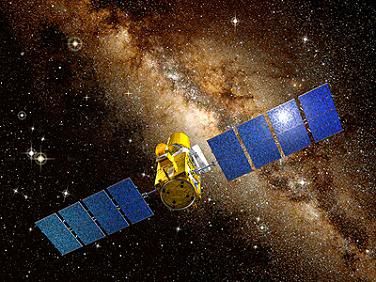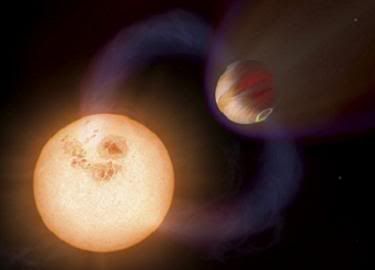Post by glactus on Jul 13, 2011 2:05:31 GMT

The Corot spacecraft
COROT is a space mission led by the French Space Agency (CNES) in conjunction with the European Space Agency (ESA) and other international partners. The mission's two objectives are to search for extrasolar planets those of large terrestrial size, and to perform asteroseismology by measuring solar-like oscillations in star. It was launched at 14:28:00 UTC on 27 December 2006, atop a Soyuz 2.1b carrier rock. COROT subsequently reported first light on 18 January 2007. COROT is the first spacecraft dedicated to extrasolar planet detection. It detected its first extrasolar planet, COROT-1b, in May 2007. Mission flight operations were originally scheduled to end 2.5 years from launch but flight operations were extended to January, 2010 and then to 2013.

An Xoplanet
COROT obtains from every observed field several thousands of light curves, from whose a lot of stellar science could be extracted: activity, rotation period, star spots, differential rotation, pulsations, in addition to the main asteroseismic program. Several papers have been submitted on the subject thanks to COROT data. COROT discovered its first two planets in 2007: the hot Jupiters COROt 1b and COROT-2b. Results on asteroseismology were published in the same year.

Corot in space
In May 2008, two new exoplanets of Jupiter size, COROT-4b and COROT-5b, as well as an unknown celestial object, COROT-3b, were announced by ESA. COROT-3b, for its mass, appears to be "something between a brown dwarf and a planet."
In February 2009, during the First Corot Symposium, the super-earth COROT-7b was announced, which at the time was the smallest exoplanet to have its diameter confirmed, at 1.6 Earth diameters. The discoveries of a second non transiting planet in the same system, COROT-7c, and of a new Hot Jupiter, COROT-6b, were also announced at the Symposium.
In March 2010 COROT-9b was announced. With 80% of Jupiter mass, and an orbit similar to the Mercury one, this is the first transiting temperate planet found known to be similar to those within our own Solar System.
In June 2010 the COROT team announced six new planets, COROT-8b, COROT-10b, COROT-11b, COROT-12b, COROT-13b, COROT-14b, and a brown dwarf, COROT-15b. All the planets announced are Jupiter sized, except COROT-8b, which appears to be somewhat between Saturn and Neptune.
In June 2011, during the Second Corot Symposium, the probe added ten new objects to the Exoplanet catalogue[25]: COROT-16b, COROT-17b, COROT-18b, COROT-19b, COROT-20b, COROT-21b, COROT-22b, COROT-23b, COROT-24b, COROT-24c. The last two planets are of Neptune size, and orbit the same star, thus rappresenting the first multiple transiting system detected by COROT. COROT-22b is also notable for its small size, having less than half the mass of Saturn.
Looking at the Corot spcecraft
Credits: These are ESA images
Text by Wikipedia
Telescope in avatar: Meade 16" LX 200
Astronomer in avatar: Glactus


